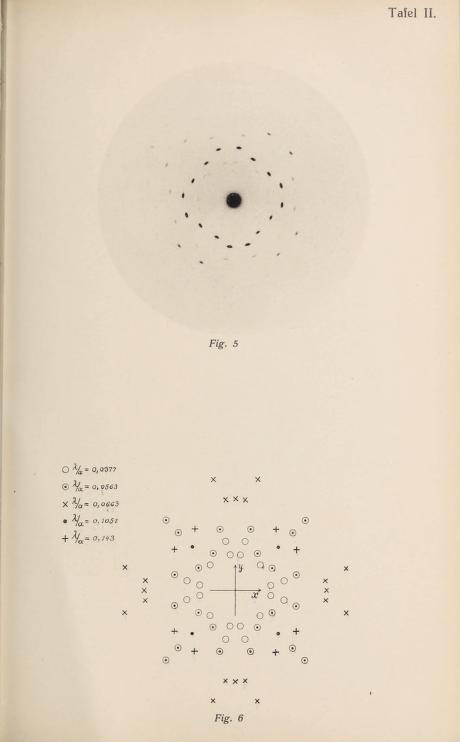Max Laue, “Theoretical Section” from “Interference Phenomena for X-Rays” (1912)
Abstract
This article on X-ray interference was written by physicist Max von Laue and his colleagues. It begins with the properties of X-rays, which demonstrated a “scattering” tendency similar to light. At the beginning of the 20th century, it was still unclear whether X-rays were tiny particles or waves. The invention of an apparatus for measuring X-ray interference (see the illustration) finally made it possible to put theoretical considerations to an empirical test. At the end of the article, Laue and his co-authors discuss why they reached the conclusion that X-rays are electromagnetic waves.
Source
Interference Phenomena for X-Rays
By W. Friedrich, P. Knipping, and M. Laue
Presented by A. Sommerfeld at the meeting on June 8, 1912.
THEORETICAL SECTION
by M. Laue
Introduction. Recent experiments by Barkla[1] have demonstrated that X-rays undergo scattering in matter closely analogous to that of light scattering by turbid media. In addition, X-rays also cause the solid to emit a spectrum of homogeneous inherent radiation (fluorescence) which is exclusively characteristic of the substance.
On the other hand, as long ago as 1850, Bravais introduced to crystallography the theory that atoms in crystals are arranged in crystal lattices. If X-rays really are electromagnetic waves, it would seem likely that the structure of the crystal lattice would give rise to interference phenomena, resulting from the atoms being excited to either free or constrained vibration. In fact the interference phenomena should be similar in nature to those known for optical grating spectra. The constants of this grating can easily be calculated from the molecular weight of the crystallized compound, its density and the number of molecules per gram molecule, as well as from the crystallographic data. They are typically found to be on the order of 10-8 cm, whereas, the wavelengths of X-rays, according to the diffraction experiments of Walter and Pohl[2] and the work of Sommerfeld and Koch,[3] are of the order of magnitude of 10-9 cm. Of course, a considerable complication arises from the three fold periodicity characteristic of crystal lattices, in comparison to optical gratings which have repetitions in only one or at most two (in the case of crossed gratings) directions.
At my suggestion, Friedrich and Knipping have experimentally tested these hypotheses. They describe their experiments and results in the second part of the publication.
[…]
General Consequences. In conclusion we discuss, but without full recourse to formulae, the question of the extent to which these experiments demonstrate the wave nature of X-rays.
The radiation emitted from crystals has a wave character that is clearly demonstrated by the sharpness of the intensity maxima. This is easily understood in terms of interference phenomena, but is almost impossible to understand on the basis of corpuscular concepts. It also has a high penetrating power which, compared to known corpuscular radiations, is only similar to that of the fastest β-radiation. Nevertheless, the wave character of the primary radiation could still be questioned. Let us suppose that the atoms of the crystal, in the case presented in Figure 5, Table II, were excited by corpuscular radiation. (The light quantum structure of X-rays, accepted by some investigators, can be included here under the description of corpuscular radiation.) In this case only those rows of atoms that are struck by the same corpuscle can achieve coherent vibration; that is, rows that are parallel to the z direction. Atoms, which are separated by certain distances in the x or y directions, would be excited by different corpuscles. A particular phase difference between their vibrations could not occur. Consequently, only one sine quotient would remain from the intensity expression (6) and we would obtain only one condition for an intensity maximum. This would be, as already indicated from symmetry bases, fulfilled by circles around the point of intersection of the primary rays. The interruption of these circles, which is actually found to occur, cannot be explained in this way. Furthermore, the primary radiation, and that emitted by the crystal, appear to be so similar, that one can be fairly certain of the wave character of the former because of that of the latter. One difference clearly remains: the radiation emitted by the crystal has considerable spectral homogeneity, that is, a certain periodicity, whereas the primary radiation, according to Sommerfeld's representation (as long as it is white radiation) is considered to consist of totally nonperiodic impulse waves. In any case, the experiments reported in the following are compatible with this assumption. It still remains to be shown, whether the periodic radiation is first generated in the crystal by fluorescence, or whether it is present with the impulses in the primary radiation and is subsequently selected by the crystal. We are optimistic that further experiments with crystals will soon provide clarification of this.
[…]

Table II.: Fig. 5 und Fig. 6 [no pagination]
(This article was translated expressly for Benchmark Papers in Physical Chemistry/4 by J. J. Stezowski.)
Notes
Source of English translation: Max Laue, “Theoretical Section,” in Walther Friedrich, Paul Knipping, and Max Laue, “Interference Phenomena for X-Rays,” in Structural Crystallography in Chemistry and Biology, edited by Jenny P. Glusker. Stroudsburg, PA, and Woods Hole, MA: Hutchinson Ross Publishing Company, 1981, pp. 23, 27-28.
Source of original German text: Max Laue, “Theoretischer Teil,” in Walther Friedrich, Paul Knipping und Max Laue, “Interferenz-Erscheinungen bei Röntgenstrahlen,” Sitzungsberichte der mathematisch-physikalischen Klasse der Königlich Bayerischen Akademie der Wissenschaften zu München, Heft 2 (1912), pp. 303-11. Available online at: https://archive.org/details/sitzungsberichte1912knig